Precious orchids: types, planting and care
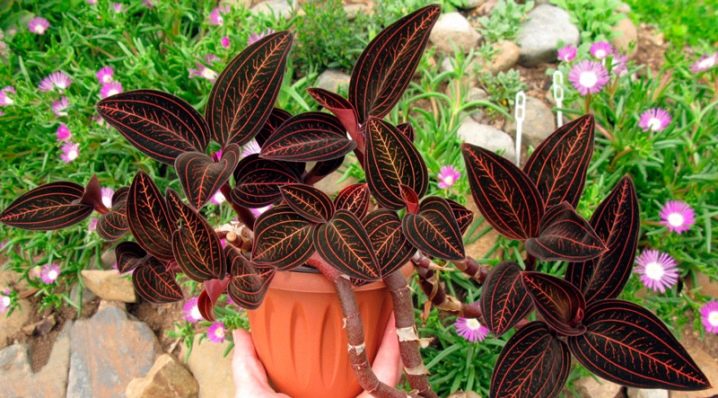
Orchid is a habitual "inhabitant" in houses, apartments and offices. This plant can be bred, collected, donated, or simply grown for pleasure. Currently, many varieties of this flower are known, among which the precious one occupies a special place.
What it is?
The main differences between the precious orchid from other varieties are not only large and beautiful flowers, but also magnificent foliage with a velvety surface, as well as unique patterns on it. The inflorescence of this plant is often nondescript, but it exudes an incredibly pleasant aroma. The color of the leaves of a precious orchid depends on the species diversity. The leaves can be silver, emerald, light green, deep cherry, red, and even black. Their shape is simple broadly lanceolate, the length of the leaf is 0.07 meters, and the width is 0.04 meters.

The color of the veins is characterized by contrast. Together, they form openwork lace with gold, silver, bronze. The homeland of this variety of flowers can be called tropical rainforests in China, Japan, India, Vietnam, and Asian countries. This ornamental plant is also found in Madagascar, Brazil, Scandinavia and New Zealand.
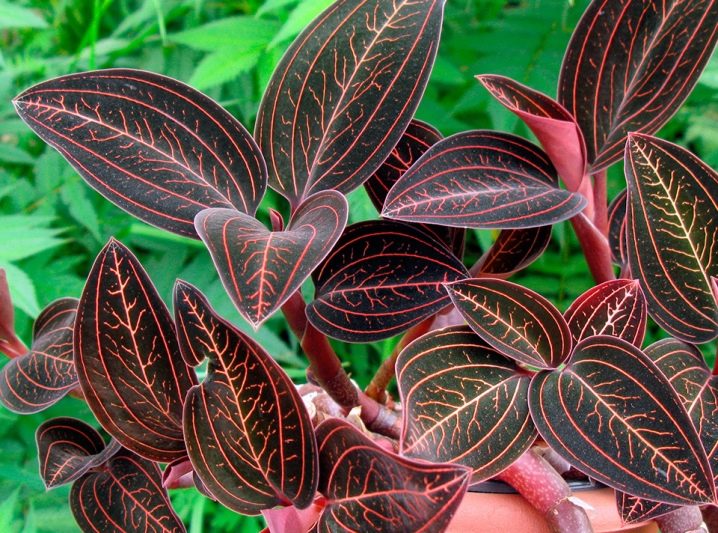
This flower is also called variegated, it is spectacular and pleasing to the eye all year round. An orchid with bright and large leaves is characterized by compactness, but at the same time looks like a precious gem with veins. The flower of the precious orchid is quite simple and in its appearance is in many ways inferior to other representatives. The flowers are often small, white, and gathered in a loose inflorescence.
Views
In nature, there are more than 200 varieties of variegated orchid, but only a few varieties are common when grown at home.
Ludisia
This representative of the species is called Ludisia two-color or "Diamond". Unlike other varieties, it is characterized by power. The flower has creeping shoots that have oval foliage with pointed ends and contrasting patterns. On dark foliage, you can find streaks of white-silver color, which are arranged longitudinally with symmetry. The plate itself is purple or deep olive.
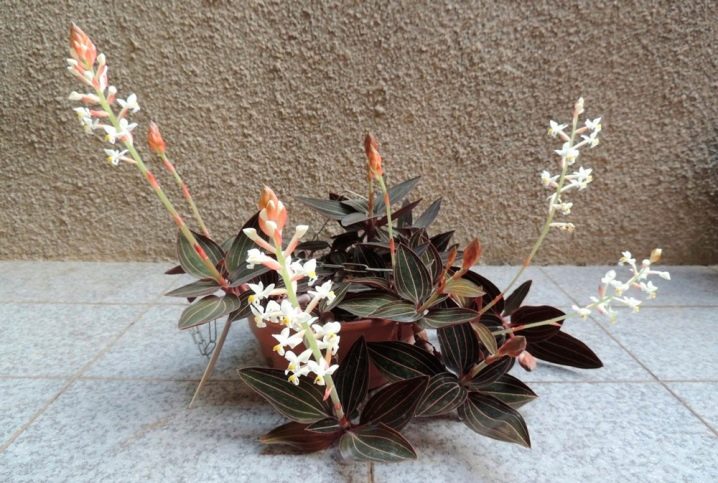
The plant blooms with small cream-colored flowers, which together represent an inflorescence of extraordinary sophistication. The main characteristics of ludisia can be called nobility and grace. Consider several varieties of ludisia.
- Ludisia "Discolor" is a rare specimen of precious orchids. The main feature of this tropical beauty is the presence of velvety silvery leaves covered with veins. The plant blooms throughout the year. It has a twisting creeping stem.
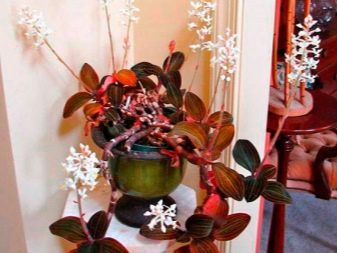
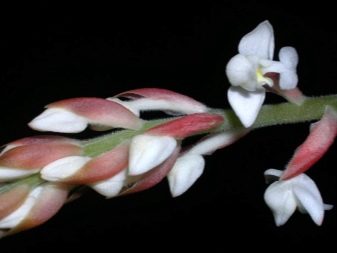
- Ludisia "Tanlaniana" characterized by wide leaf plates, which are covered with patterned mesh in the center.
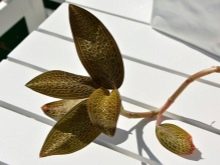
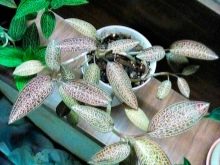
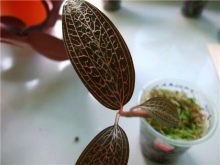
- Ludisia "Alba" has a simple light color, in which there are no red and burgundy shades. There are longitudinal white stripes on the foliage.

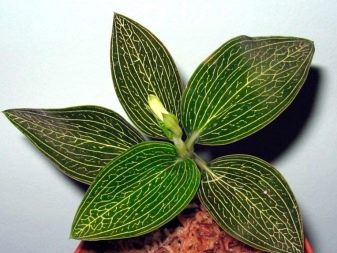
- Ludisia "Velvet"... The leaves of this plant have a rich green color and a velvety surface. There are longitudinal red stripes on each side of the plate.

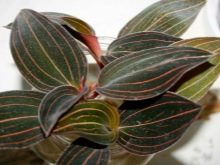
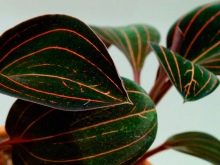
Makodes
This type of terrestrial orchid has a creeping shoot up to 8 centimeters high, it is characterized by dense branching. This variegated plant has oval leaves with pointed ends and a beautiful velvety edge. The leaves are painted in light green, dark green, grayish, emerald green, while their length is no more than 7.5 cm. When viewed from the plant, it seems that it is decorated with gold lace. During flowering "Makodes" produces 20 whitish-brown flowers, which are located on a long peduncle.
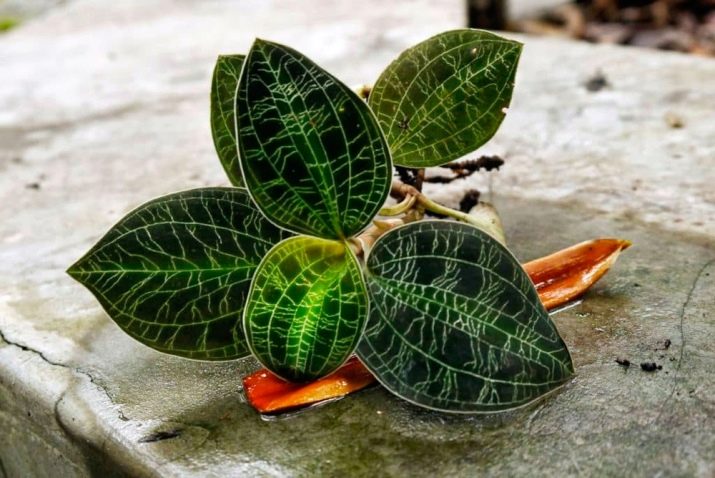
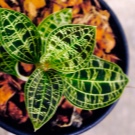
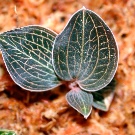
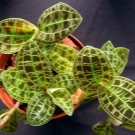

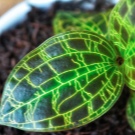
Anectochilus
This type of indoor plant is a miniature representative of orchids, its height does not exceed 0.15 meters. The plant has greenish brown foliage with gold and silver veins. They look like cracks in the foliage, emphasizing the glossiness of the leaf texture and the correctness of its shape. The leaves of the orchid are large, and the rosette is characterized by density.
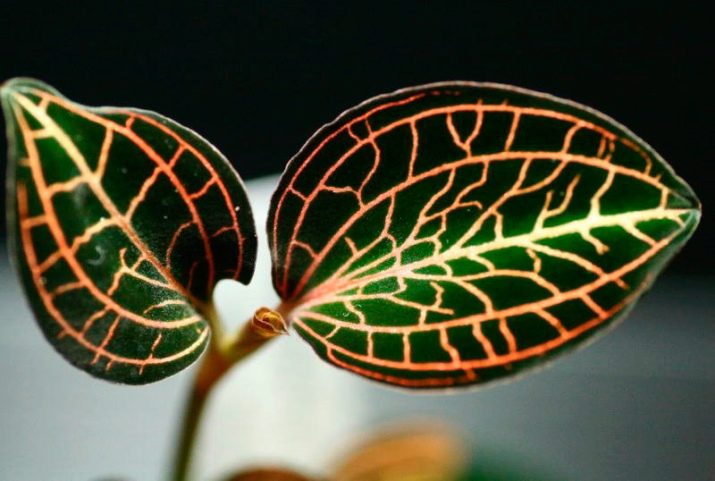

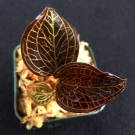

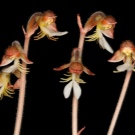

Planting and transplanting
If you grow a precious orchid at home, you need to transplant it annually. The pot should be changed when the previous container becomes small. Often, you need to change the pot once every few years. The flower is planted in a special soil, which consists of garden soil mixed with peat, pine needles, foam balls, coconut fibers, humus, sphagnum moss, pine bark, charcoal.
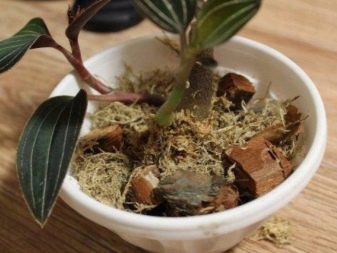
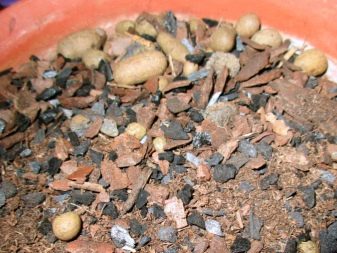
The bottom of the pot should be filled with the largest elements, the smallest fit on top. Transplanting a precious orchid is carried out in the following stages.
- The bottom of the container is laid out with a drainage layer of 3 centimeters. Small expanded clay, brick chips or perlite can become the constituent parts of the layer.
- The next step is to fill in the soil layer. As a result, the pot should be half full.
- Then the flower should be examined for the presence of damaged and rotten roots, with their subsequent elimination. Sections must be processed with activated carbon and dried.
- The root system must be sent to the pot, while not deepening it, then sprinkle with a substrate so that it is evenly distributed.
- Put sphagnum moss on top of the soil, it will retain moisture.
- After transplanting, the flower must be placed in a warm room, where there is high humidity, and there is no draft. After a few days, the orchid can be put back in its original place.
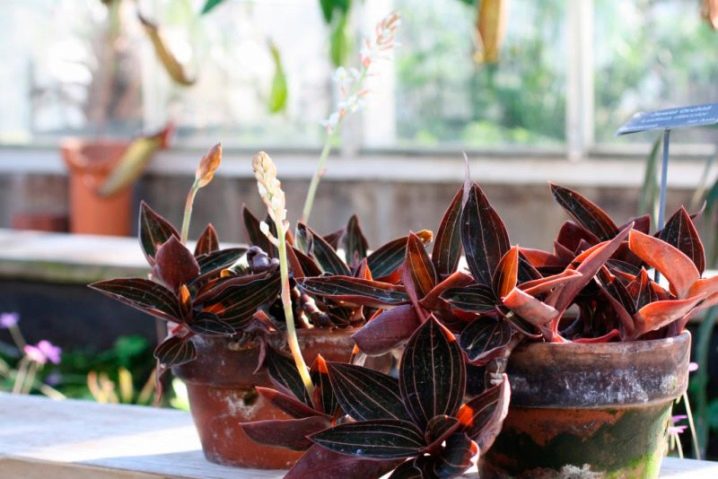
Care
The difference between a variegated orchid from a blooming one is its undemanding care. But, like any other indoor flower, it needs the right lighting, temperature, watering and fertilization. Nevertheless, there are usually no difficulties in growing this plant, a miniature orchid is simple and uncapable, even an inexperienced florist can handle it.
This type of plant feels great in diffused lighting. Do not expose the flower to direct sunlight. Some types of variegated orchid can grow under artificial lighting. Growing a plant is possible not only on window sills, the orchid is comfortable in darker areas of the premises. The florist can learn about the lack of light thanks to rarely located small leaves.
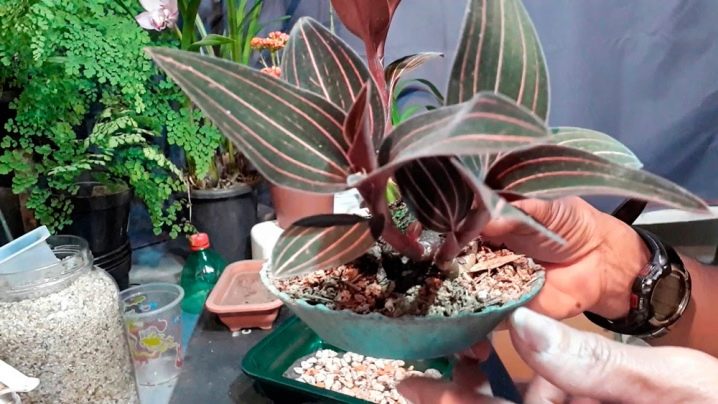
Precious orchids love to carry out their vital functions at normal room temperature. Sharp temperature drops are considered detrimental to the plant, and the temperature in the room should not be allowed to drop below 18 degrees. An important factor for the normal growth and development of a precious orchid is moisture and regular watering. The presence of a moisturizer near the flower will be useful.
The variegated representative requires regular intensive watering. It is not worth bringing to drought and drying out of the soil, since they are detrimental to the orchid. Watering should be continued until the soil is completely saturated with liquid.In the cold season, irrigation should be carried out less frequently, observing the moisture content of the soil. You can irrigate the plant with any water, not excluding thawed, rain, boiled water.
Diseases and pests
The precious orchid often suffers from improper care. If the plant is very elongated, then this indicates a lack of light. In such a situation, it is worth providing the flower with an additional source of illumination. When the humidity in the room is low, the tips of the foliage dry out and grow dull. To eliminate the unpleasant symptom, it is required to spray the orchid in a timely manner.
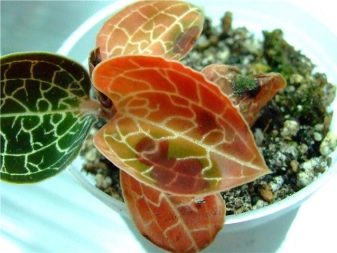

If the indoor "inhabitant" fades and turns pale, it means that he suffers from the influence of bright lighting. When growing an orchid on a window, it should be shaded a little. In a situation where foliage turns red, the problem may lie in excessive moisture. It is for this reason that it is recommended to irrigate the flower only when the top layer of the soil dries up.
Let us dwell on the common infectious and fungal diseases of the variegated orchid.
- Root rot. The disease manifests itself in yellowing of foliage, wilting, blackening of the root system, as well as in an unpleasant odor. If the plant is slightly affected, then it is enough to rinse the roots in a manganese solution. After that, the orchid is transplanted into a new substrate, and also not irrigated for a couple of days. As a preventive measure, it is worth observing the watering regime.
- Stem rot. The manifestation of the disease is observed in the appearance of rotting areas on the stem. At the initial symptoms, the area should be cut off and the area should be treated with crushed coal. The flower should be transplanted into a soil mixture that has been disinfected in advance. With large areas of stem damage, the apex is rooted, that is, a whole stalk.
- White rot. This is a type of fungal disease that can infect the stem from the inside. The disease is hardly detected at the initial stage. There is no cure for this disease, the diseased plant must be destroyed. As a preventive measure, you should observe the regularity and correctness of watering, disinfect the substrate before planting a flower, and also fertilize the plant regularly.
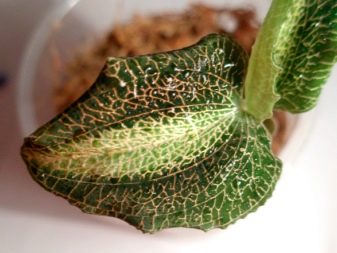
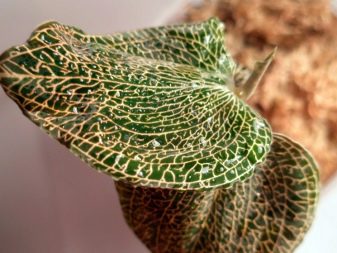
The most dangerous and common pests of the precious orchid include the following representatives.
- Spider mite. In the presence of this parasite, punctures can be found on the stem and leaves. A clear sign of a tick attack is the formation of a cobweb on the back of the leaves. Having found a pest on a room orchid, the florist must process it with Fitoverm, Mospilan, Aktara. If the degree of damage is severe, then spraying is carried out three times, with an interval of a week. Preventive measures are to treat with tampons that have been moistened with soapy water. Also, do not forget about maintaining an optimal level of humidity.
- Mealybug. The parasite is a shaggy white insect, after which a plaque with a sticky consistency remains. Severe worm infestation causes foliage to die off. The methods of control and prevention are identical to the previous case.
- Shield. This is a pest that has a shell. In the course of its life on an orchid, it causes yellowing and shedding of leaves. The fight and prevention is the same as with the spider mite.
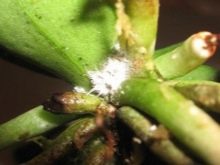
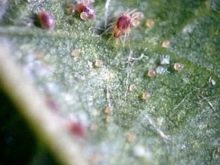

Reproduction
The breeding process for precious orchids is not complicated. There are several options for this procedure: cuttings, stem elements, bush division. The latter method is used when transplanting a flower. The bush that has grown is divided into parts, each of them must contain at least 3 processes. Planting of planting material is carried out in a previously prepared soil.
Cutting propagation can be carried out throughout the year, however, the best period for such a procedure is from April to June.
The apical cutting should have 3 leaves and at least 2 nodes.To prevent the plant from rotting, the wound should be treated with crushed coal, followed by drying. The rooting process is carried out using moss. The stalk is buried in the soil to the base of the foliage, after which the planted plant is covered with a jar.
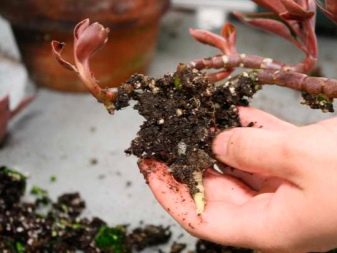
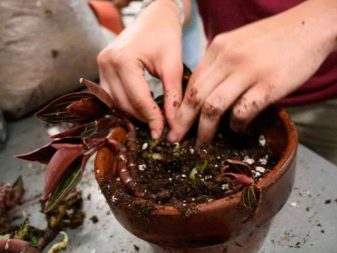
According to some flower growers, rooting of cuttings is possible when they are immersed in water, which should be changed according to the degree of its turbidity.
For best results, add some activated carbon to the liquid.
Then the leafless stem is rooted, for this it must be cut into segments so that each of them has several internodes. The resulting wounds need to be treated with crushed activated carbon. Then the parts of the orchid should be laid horizontally on moistened moss. The plant does not require deepening; it is enough to press it in a little.
For a video on caring for precious orchids, see below.
See the video on transplanting a precious orchid below.































The comment was sent successfully.